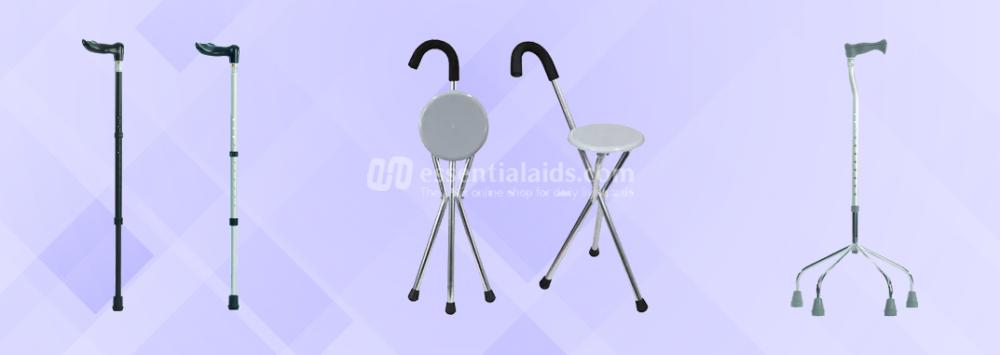
Things to Consider with Walking Sticks
Sally Madeley-Carr, OT29 Oct 2020
Walking sticks are perhaps the most basic mobility aids. They assist with balance and provide a simple, easy to control support for those who need it as the walk.
Traditional walking sticks were wooden, and while this is still a popular choice, adjustable aluminium sticks are now popular, mainly because of their light weight and adjustability.
Here we'll run down some of the variables with walking sticks and explain a bit about the different kinds available.
Walking stick handles
There are now alternative handles to those on traditional walking sticks, with their curved, relatively narrow wooden handles.
Other old-fashioned handles were made from metal, bone or even ivory.
Depending on the diameter, it is possible that this type of handle can cause pain in the hands, especially for people with arthritis or other conditions which lead to inflammation.
Softer plastics and foam may be found on some walking sticks in order to improve comfort.
Another alternative is the contoured 'fischer' design of handle. These have been carefully designed to reflect and be sympathetic to the curvature of the hands and fingers.
The width of the fischer handle is also wider than a conventional stick, meaning the user's weight is spreadly more evenly.
Stick height
It is important to use a stick which is the correct height. If it is too low, it could hurt your back; too high and it may not provide the necessary support.
As an approximate rule of thumb, the stick's height from the ground to the handle should come up to your wrist crease when your hands are hanging loose by your sides.
Wooden sticks need sawing to the correct length, while extendable aluminium ones can be easily adjusted.
Aluminium walking sticks
Sticks made from aluminium tubing have a number of advantages which has seen them grow in popularity.
One is that they are very light weight. If you are elderly or have a condition which reduces your strength, a light stick makes for an ideal walking aid.
In its tubular form, aluminium is also extremely rigid and strong, making it a practical material for this purpose.
Most sticks made from aluminum have two shafts: one which slots inside the other.
The length of the overall stick can therefore be adjusted by means of a pin-clip mechanism, which allows the lower shaft to protrude and lock in place at the desired length.
This is an improvement over wooden walking sticks, which have to be cut to the desired length and then can not be readjusted later.
Most aluminium sticks are fitted with handles designed to apply pressure evenly, spreading the user's weight and making them less likely to cut into the hand.
If you do go for a contoured handle, make sure you choose one which is suitable for the hand you want to hold the stick with. The contours make these sticks appropriate for either one or the other.
Walking stick ferrules
The cap which fits to the end of the walking stick is called a 'ferrule'.
For use on rough ground, the ferrule maybe metal, while in other cases a rubber or plastic version will be attached.
Metal ferrules are traditional and great for soft ground, but tend to slip on hard surfaces. Rubber or plastic versions are now much more commonly used.
This type will absorb some of the weight of the user, retain its shape, prevent the stick from slipping and protect the end from splintering or degrading over time.
Essential Aids supplies a high-quality range of walking sticks and ferrules, available in various diameters. Most have internal metal discs, which prevent the ferrules cutting through and allowing the base of the stick to be exposed to the ground.
Without this disc, tubular metal sticks are especially prone to cutting through the soft material.
'Flexible' ferrules take the concept a step further by containing a spring-loaded mechanism which keeps the bottom of the stick in contact with the ground for an extended period.
They have a flexible neck component which some people feel makes the stick more stable and less likely to slip.
Folding walking sticks
Folding canes are excellent walking aids which you can transport in a handbag or rucksack.
Most designs have three short sections of aluminium metal tubing which lock together when in use, making the complete walking stick.
The three sections are internally connected via a length of elastic, which keeps them together when they are in their separated state.
Walking stick straps
A loop of material or leather attached to the handle is a useful accessory for walking sticks as they reduce the chance of them falling to the ground.
While this may seem like a minor benefit, reaching items on the floor may actually be a serious difficulty for people with certain physical conditions.
Walking aids with multiple legs
If more support is required than a conventional walking stick can offer, you might consider one with three or even four legs. Essential Aids supplies a range of exactly this type of product.
While these mobility aids are certainly heavier, they offer some key advantages, with stability being top of the list.
Three-legged and four-legged sticks also have the benefit of standing up alone, without having to be rested against something.
As mentioned above, this is a significant benefit to someone who may find it challenging to bend down to floor level.
Sticks with three legs tend to be slightly more maneuverable than those with four, but the latter offers the maximum stability.
This type of mobility aid is not for moving fast. They're typically used around the home by people who require extra support.
Their legs are usually made from steel, with an upper shafter of aluminium.
Wooden walking sticks - how they are made
Traditional wooden walking sticks are not only supportive walking aids, but can also look aesthetically pleasing.
Chestnut is a traditional wood from which to make walking sticks. It is used because it is lightweight and durable. It is usually harvested as a three or four-year-old sapling.
The sticks are cut to a rough length, the bark peeled and then thoroughly dried out. The wood is then washed, often using a rotating tank, to remove any surface mould or wood decay.
Once stripped and cleaned to the required degree, the sticks are then bent so that they have the familiar curved handle of a walking stick.
This process requires the chestnut stick to be softened. A traditional method towards this end is to use steam. The straight sticks are inserted into a purpose-built machine in which the steaming takes place.
It takes around twenty minutes for the moisture to sufficiently penetrate the wood, making it soft and malleable enough to bend without splitting or cracking.
Long levers and brute force were used in traditional walking stick manufacture, in order to exert enough force to bend the stick.
Other methods are now more common, like mechanical spring-loaded arms which wrap the wood around a 'form', which provides the distinctive shape of the 'crook' or handle of the stick.
At this stage of the process, the wood is still relatively pliable, so it is then tied into its new shape so it can harden. Now held firm, the bending arm can be retracted.
The 'straightness' of the stick's shaft may then be adjusted by using a traditional tool called a 'straightening horse'.
This comprises a thick wooden column with various off-shoot blocks which can be used together in order to leverage kinks and small bends out of the stick.
This process requires some skill by the worker and no little strength.
Once the stick has been straightened, it goes into a drying room to expel any moisture from its interior, and firm up its new shape.
With a temperature of around 80 degrees, the sticks remain in this environment for two or three days.
The next stage of the process involves a sanding and cutting wheel. Using this, the stick is cut to the desired length and the tip is made narrow in order to fit the 'foot' or ferrule to the bottom.
Also at this stage the wood is 'de-knotted' to make it smoother to the touch. This is done by means of a spinning sanding wheel, against which the wood-worker presses any knots to grind them off the surface.
Another sanding machine, which works like a pencil sharpener, is used to round off the handle end of the stick, giving it a softer finish. This is called 'nosing'.
The stick is then finished with varnish so that it is protected from absorbing moisture and to provide an attractive top-coat.
The final step in the process is to add the stick's ferrule.
Walking 'stick-seats'
These inventive devices combine a walking stick with a portable stool. They're great for short journeys on which you might still need to sit down.
Essential Aids supplies a number of variations, but the basic design involves a round seat which folds against the shaft of the stick as you walk.
When the seat is required, it folds out and locks in place as the individual's weight is placed on it.

Sally Madeley-Carr, OT
Sally qualified as an Occupational Therapist in 1996 and is a well-respected professional in the field of rehabilitation equipment and living aids. She has worked in private practice and within the NHS, developing a broad experience with adults and children. Click here for Sally's registration with the Health and Care Professions Council. The HCPC regulates health, psychological and social work professionals in the UK.